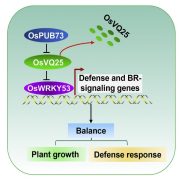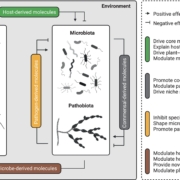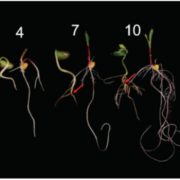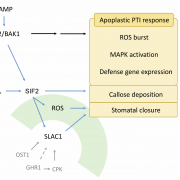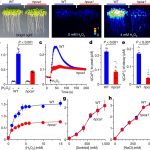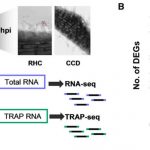The pan-genome effector-triggered immunity landscape (Science)
 Successful plant pathogens produce a suite of small molecules called effectors that are injected into plant cells and perturb plant defense. As a counter defense, plants have evolved intracellular receptors (called NLRs; nucleotide-binding domain leucine-rich repeat) that detect specific effectors and mount strong effector-triggered immunity (ETI). Compared with an immense diversity of bacteria and their effectors, plants carry a relatively small number of NLRs, but at the same time they are not susceptible to most of the bacterial species. To better understand the role of ETI in determining pathogen host range, Laflamme et al. set out to systematically screen effectors for their ability to trigger ETI in A. thaliana. They created the P. syringae Type III Effector compendium (PsyTEC), from thousands of strains, covering all 70 effector families. By expressing the effectors in P. syringae DC3000 and screening for ETI, they identified 19 ETI-eliciting effector families, which they further characterized using a panel of NLR mutants to identify novel effector-NLR pairs. The results predict that A. thaliana has near-complete immunity to a wide range of P. syringae species, mediated by as few as eight NLRs with a particularly broad contribution from the NLRs ZAR1 and CAR1. This study provides a valuable insight into the role of ETI in constraining bacterial host range and sets the foundation for investigating an even larger set of effector-NLR interactions and effector-effector interactions in the future. (Summary by Tatsuya Nobori) Science 10.1126/science.aax4079
Successful plant pathogens produce a suite of small molecules called effectors that are injected into plant cells and perturb plant defense. As a counter defense, plants have evolved intracellular receptors (called NLRs; nucleotide-binding domain leucine-rich repeat) that detect specific effectors and mount strong effector-triggered immunity (ETI). Compared with an immense diversity of bacteria and their effectors, plants carry a relatively small number of NLRs, but at the same time they are not susceptible to most of the bacterial species. To better understand the role of ETI in determining pathogen host range, Laflamme et al. set out to systematically screen effectors for their ability to trigger ETI in A. thaliana. They created the P. syringae Type III Effector compendium (PsyTEC), from thousands of strains, covering all 70 effector families. By expressing the effectors in P. syringae DC3000 and screening for ETI, they identified 19 ETI-eliciting effector families, which they further characterized using a panel of NLR mutants to identify novel effector-NLR pairs. The results predict that A. thaliana has near-complete immunity to a wide range of P. syringae species, mediated by as few as eight NLRs with a particularly broad contribution from the NLRs ZAR1 and CAR1. This study provides a valuable insight into the role of ETI in constraining bacterial host range and sets the foundation for investigating an even larger set of effector-NLR interactions and effector-effector interactions in the future. (Summary by Tatsuya Nobori) Science 10.1126/science.aax4079
[altmetric doi=”10.1126/science.aax4079″ details=”right” float=”right”]



